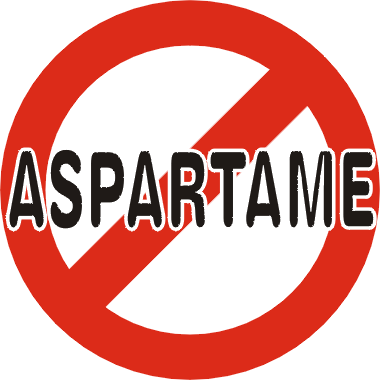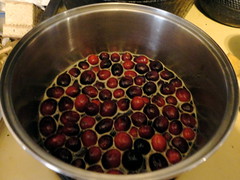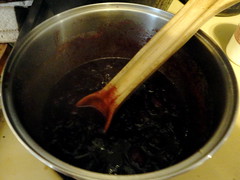Just in Time for Valentine's Day: The Bitter Truth About Sweets
... How Real Food Nutrition Taught Me A Few New Tricks!
My eldest daughter bought a 1 litre jug of clarified apple juice and it made my youngest daughter quite wonky. She was unable to pay attention or read and ended up collapsing in exhausted tears. Such is the price of a sugar high, even a natural one! I am always inwardly horrified when I see parents offering and sharing tetrapak “juices” with added sugar. Clarified apple juice is as far as I let it go, although I only buy organic apple cider.
North Americans eat as much sugar in two weeks as our great grandparents ate in a year. Sugar used to be a score in the form of fresh ripe fruit brimming full of nutrients and fibre. Now, alas, we can get sugar anytime we like - nutrient and fibre-free. Our bodies process sugar in the liver, and use the formerly rare opportunity to build fat reserves. So our consumption of sugars:
1. overtaxes the liver
2. contributes to unhealthy amounts of body fat

Sugar in the absence of food is poison. I count on sugar in the presence of fats say like coconut ice cream fats, and chocolate chip fats, and raw nuts in cookies fats, to be non toxic! While we shun sugar-added fruit juice, we do enjoy making our own lemonade from maple syrup and lemon juice. Still, I’d rather see sugar on the label than High Fructose Corn Syrup or a maltodextrin sounding word. Dr Mercola writes: If you’re consuming a food or beverage created in a lab instead of by nature, you can be assured your body doesn’t recognize it. This opens the door to short-term and long-lasting health problems for you and your family.
The Demonized "Carb"
Carbohydrates, presently the bad guy of nutrition up against our new hero protein, are components of food known as starches and sugars. Starches, such as those found in grains and potatoes are mostly long chains of glucose. Sugars, such as those found in fruit and, well, sugar, of course, are simple chains of glucose and fructose molecules. Table sugar is 1 glucose to 1 fructose, while agave, fruit, high fructose corn syrup and the like contain more fructose than glucose. And, in short, that's really bad for us.
So what's the difference between sugars?

Strangely, fructose and glucose are quite different in terms of health. Only 20% of glucose is broken down by the liver, whereas fructose is entirely broken down in the liver. Only 1 out of 120 calories of glucose is stored as fat, whereas 40 out of 120 calories of fructose is stored as fat. The metabolism of fructose by your liver creates waste products and toxins, including a large amount of uric acid, which drives up blood pressure and causes gout.
Prepostrously Poisonous Sweeteners are:
Agave Nectar, commercial is derived from boiling the sap of the blue agave plant. Although it has a low glycemic index, its high fructose content make it the sugar equivalent of crack in the body. Plus, most commercially available agave is converted into fructose-rich syrup using genetically modified enzymes and a chemically intensive process involving caustic acids, clarifiers, and filtration chemicals.
Aspartame aka NutraSweet aka Equal aka Neotame is an excito-toxin that breaks down into methanol, which in turn breaks down into carcinogens. 
Corn Syrup aka High Fructose Corn Syrup is fructose...
Fructose depletes vitamins and minerals and can lead to cardiovascular disease, liver disease, diabetes, obesity, cancer, arthritis and even gout. Fructose becomes a metabolic poison when we eat more than than 25 grams a day, but most of us eat 70 grams a day!
Saccharin and Sodium Cyclamate Originally derived from natural plant sugars, these Monsanto lab creations have been long associated with many problems including early results that it caused cancer tumours.
Splenda aka sucralose is an altered form of sugar that reduces good bacteria and increases acidity in the intestines, and can lead to drug insensitivities and a host of horrible side effects.
Seemingly Sketchy Sweeteners are:
Xylitol is a powder originally derived from birch bark that is now produced from corn, berries and plums. Although natural, it can cause digestive chaos like bloating and the runs.
So-Far-So-Good Sweeteners are:
Agave Nectar, ethically sourced such as from ChocoSol is derived from boiling the sap of the blue agave plant. Ethical agave makers: work with the indigenous people,
use organic agave, free of pesticides, process agave at low temperatures to preserve all the natural enzymes. The final product is closer to 50% fructose instead of over 90% and
the fructose is bonded or conjugated to other sugars and not floating around as “free” fructose, like HFCS, which is far more damaging.
Coconut Palm Sugar has a low glycemic index, and high nutrient content.
Date Sugar contains all the vitamins, minerals and fiber present in the same amount that was present before being ground.
Real Fruit and Whole Juice The Creator did not make a bad fruit. Try boiling dried fruit up into a syrup for making squares, sweeten smoothies and make ice cream with over ripe peeled bananas, snack on dried fruit from a bulk store, or take along nature's own packaged foods in the form of an apple, a banana or an orange.
Raw Honey is a medicine that helps maintain blood sugar levels, provides vitamins, minerals, and antioxidants, and can be used as an antiseptic on cuts, burns, and wounds.
Lo Han Guo is from a fruit found in East Asia, where it has been used medicinally for throat infections and coughs, constipation, heat stroke and even diabetes. I've never tried it, but apparently you can buy it as 5% sugar cubes in Chinese food stores.
Real Maple Syrup is composed of balanced sugars, minerals (potassium, calcium, magnesium, and manganese), vitamins (PP (Niacin), B5 (Pantothenic Acid), B2 (Riboflavin), Folic Acid, B6 (Pyridoxine), Biotin, and Vitamin A) and amino acids. Yay! Buy Local!
Brown Rice Syrup is made by culturing cooked rice with enzymes and is roughly 50% soluble complex carbohydrates, 45% maltose, and 3% glucose, so it has a time-release effect on blood sugar.
Sucanat aka Dried Cane Juice is good. Period. Okay, it's 50% fructose, 50% glucose, but it's natural. Just make sure it's Fair Trade.
Stevia an herb that is 200 times sweeter than sugar, used by South Americans for centuries. Avoid the plastic bottles and individual pouches, and buy a glass tincture bottle, the dried herb, or even a plant! Just pick a leaf to sweeten your tea!

Sorghum from the grain has nutritional properties such as iron, calcium, potassium and anti-oxidants.
We buy fair trade evaporated cane juice, demerarra sugar, raw honey and bulk maple syrup and use these mainly for baking. The last time we had sugar sugar here was when I found that my tenant had dumped an unopened kilogram bag of white sugar in the compost heap. I put it in my cupboard and used it 50/50 in recipes over 2 years. That's done, and now the sugar I am most concerned about in our diets is that which is added to our store bought almond milk.
We've been experimenting with substituting flours as well as sugars this holiday season.
My most notable "up the nutrition" substitution ideas are as follows:
1. BAKED GOODS Halve the recipe's quantity of sugar in raw cane sugar/sucanat/demerarra.
2. TEA Add a teaspoon per pot of stevia leaf instead of sugar or honey.
3. SWEET BREADS Use coconut cream instead of shortening/lard/oil/margarine/butter
4. BAKED GOODS Use soaked mashed dried fruits instead of sugars in bars, squares etc
5. SWEET BREADS Use mashed bananas instead of sugar in banana and other sweet breads.

Here is my recipe for cranberry sauce:
1. Put cranberries, from Wahta Mohawk Territory's organic cranberries here, in a pot and cover with water
2. Add an equal to half quantity of natural sugar such as scanat (dried cane sugar).

3. Bring to a boil, then let simmer until the cranberries burst and the sauce is thick enough to
your liking.

Here's my favourite line about sugar, by singer Melanie Kafka:
I don't eat white flour. White sugar makes you rot.
Oh, white can be beautiful, but mostly, it's not.
And here's my favourite treat:

Mahem Bars, mailed to me without the plastic wrapper! - from a family run business dedicated to the production and promotion of hemp. The Mahem Bar is a combination of maple syrup and hemp nuts, and is coated in dark chocolate. They are produced hand made at Village Treats, a chocolatier production in Balderson. The maple syrup is supplied by Lanark County's Diane Coutt's in Rideau Ferry, Ontario and the hemp seeds are processed by Purity Hemp in Peterborough, Ontario. Finally, they are packaged and distributed from Mayhem's home in Rideau Ferry, Ontario.
Savour sweetness in safety,
Tracey

